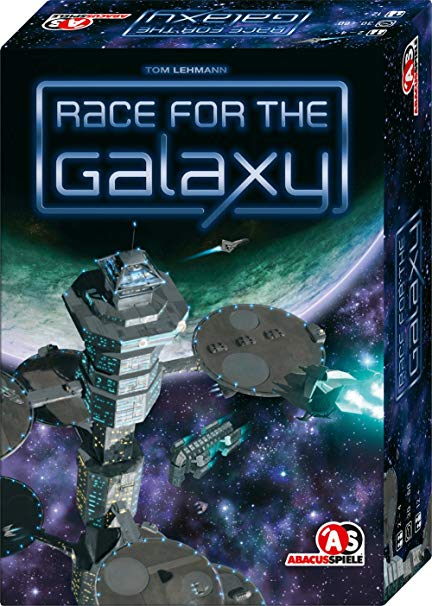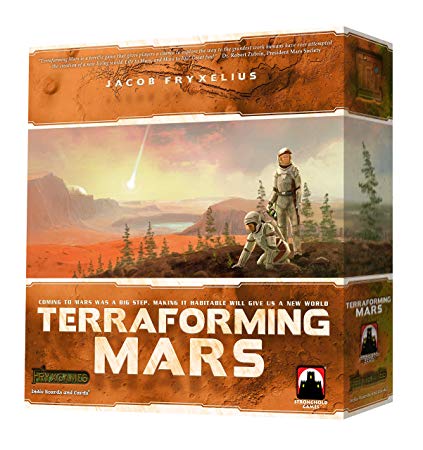In my last installment of this blossoming series, I suggested Forbidden Island as a starting point for getting into role-based cooperative games. From there, we turned up the heat with Flash Point: Fire Rescue before putting on our hazmat suits to cover Pandemic.
But I’m done playing nice! No more co-op board games! It’s hot, I’m covered in sand, and I’m definitely coming down with a low-grade fever…
This time around we’re shifting gears (literally) to talk about engine-building board games! For those of you unfamiliar with the termengine-builder, these games revolve around creating an ecosystem that generates resources. Depending on the game, this could mean points, wood, mechs, unicorns – anything.
At the beginning of the game, the engine starts off slowly before gradually pumping out resources at a rapid rate. It is really satisfying to see your creation grow – hopefully you can keep it in control! (More on different types of board games.)
First, pull out your jeweler’s loupes for our entry-level engine-builder, Splendor. Once we’ve had our fill of peddling gems, we’ll blast off to the stars with Race for the Galaxy. All that space travel will certainly make us homesick so we’ll need to settle down. How about the Red Planet? Terraforming Mars rounds out our venture!
Progress Makes Perfect: Splendor

For the entry-level board game, I was really torn between Splendor and Century: Spice Road. Both are similar games revolving around commodity trading, but at the end of the day I felt like Splendor is a bit easier to grasp. If you’re interest in the Century series, here is an article about the second installment in the series, Eastern Wonders.
Splendor is a game about buying gem mines and earning prestige by displaying your great wealth. Although engine-builders can be difficult for newer players to grasp, Splendor is about as barebones as it can get. Once again, there are only three actions players can take on their turns:
- Add gems to your pile, which can be used to purchase mines
- Buy/build a mine card by selecting from the tableau of available cards
- Reserve a card for later and acquire a gold (wild) gem
The turns pass with players buying mines and building up a cache of gems in front of them. Each mine that is built is going to provide a ‘free’ gem resource, as well as granting victory points (VP) towards the end-game scoring.
This is where the engine-building aspect comes into play. By building more mines, players are going to have more resources at their disposal. These can be used to purchase low VP cards for cheap (read: free) or fuel the engine in pursuit of more valuable cards.
There is a delicate balance between amassing mines to build your engine and focusing on victory points. At the end of the day, it doesn’t matter if your engine can buy any ruby-gem cards for free if you don’t have any points; the game ends at 15 VP.
At their hearts, most engine-building games share this same concept. While it’s boatloads of fun to create a massive engine, knowing when to switch gears towards the endgame is a skill acquired with time.
Here are the main mechanics introduced with Splendor:
- Engine building
- Limited set of player actions
- Set-collection
- Victory points
- Card drafting
One of the main downsides of Splendor is that it isn’t the most social game in the world. Player interaction comes in the form of denying other players from coveted cards, otherwise the game is akin to Solitaire. This can be a pitfall of many engine-builders, so just keep that in mind.
Got your spacesuit on? To the stars!
Progress Makes Perfect: Race for the Galaxy

Are you addicted to card games? Have you ever wanted to create an empire…in space? Do you dream of intergalactic economics? If you’ve answered with a resounding ‘YES’ to any of these questions, then Race for the Galaxy is for you!
The objective is to develop a civilization by playing cards that affect the general infrastructure of your empire. These cards all contribute to the end-game either in number (first player ending a round with at least twelve cards) or through victory points (VP).
Unlike Splendor, players have many more actions to take on their turns. These actions are divided into Phases to help keep a semblance of organization, but it can be daunting at first glance. Essentially the game progresses as follows:
- Phase I – Explore by drawing cards and discarding
- Phase II – Develop by playing a development card from your hand and paying its cost with other cards
- Phase III – Settle by playing a world card from your hand and paying its cost
- Phase IV – Consume by using consume powers to discard (gain VPs) and draw
- Phase V – Produce by placing goods face down on production worlds.
Cards are going to be flying in all directions here. Between the constant discards, playing, and draws, hands are being recycled CONSTANTLY. This can complicate things for new players as they learn what the icons on the cards represent. As mentioned before, this can be a common theme with engine-builders; learning what strategies work and don’t work comes with time.
Eventually, players reach the end of the game and points are added up by combining the totals from any VP chips, their tableau of cards in their civilization, and any extra VPs from high-cost development cards. Highest points wins.
I chose Race for the Galaxy as the perfect bridge game between Splendor and Terraforming Mars because of the overlapping mechanics, but also because of the mechanics they don’t share. You’ll see the similarities once we get to the third game.
As far as mechanics go, here are the things you’ll experience in Race for the Galaxy, including checks next to ones introduced to us by Splendor:
- Engine building – Check!
- Limited set of player actions – Kind of…
- Set-collection – Check!
- Victory points – Check!
- Card drafting – Nope!
- Intricate cards (in Abundance)
- End-of-game point salad
Not much new here apart from the complexity of the cards. This is important as we venture back to the fourth rock from the Sun, because our next game has a TON of cards.
Seriously, I should weigh them out.
The card drafting component is also new to us, if we’re comparing Race for the Galaxy in a vacuum. If you’ve ever played Dominion or Magic: the Gathering, odds are high that you’re familiar with the concept of selecting one card from a field of many. It’s just like picking teams for kickball: try to get the best possible players on your team to give yourself the greatest odds of winning.
Or like picking the best astronauts to help colonize Mars, which is where we’re going next.
Progress Makes Perfect: Terraforming Mars

Terraforming Mars. It’s the game where rival corporations are competing to carve out their slice of profit from the arduous task of making Mars habitable for colonists. We already have a write-up of this wonderful game so be sure to check that out for a more comprehensive review.
The elegance of the game comes from the players working together to improve the quality of life on the red planet. Over the course of the game, players are trying to place water tiles, raise the oxygen levels, and warm up the surface. Doing any of these will grant players victory points, so it’s in your best interest to help out in some way.
It would be pretty boring if people came to Mars and there was nothing to do there, though. That’s where cities and greeneries come into play. At first glance, these might not be the most attractive tiles to produce. However, they are going to be incredibly beneficial during the end-game scoring, so it’s another thing to keep your eye on as the game progresses.
At the same time, players can also earn points through the cards that they draft and play. Remember when I said there are a TON of cards? Between amassing microbes, collecting Jovian tags, or housing pets, there are numerous avenues that players can take to earn some extra points to their pool.
Each player can take one or two actions each turn before passing to the next player. Play continues this way until all players ‘pass’ and the generation is over. At this point, resources are produced and income is generated in preparation for the next generation of terraforming.
On you turn, you have a limited number of actions that you can perform:
- Pay the costs of a card/project to play it and gain the benefits
- Complete a standard project available to anyone
- Perform an action on one of your blue cards
Now, obviously you’re going to be constrained by your own resources, so the key becomes sequencing your turn in a way to gain the most benefit. You may want to hold off on raising the temperature if you anticipate another player is going to do it in order to gain an extra bonus.
Again, this game does suffer a bit from the ‘solitaire’ mentality that usually traps players in engine-builders. The main difference is that, since everyone is terraforming Mars together, the gamestate is always changing. This, in turn, affects your turn sequencing and planning.
It’s interactive by seemingly being the opposite.
So how does the complexity stack up against the other two games we’ve talked about? Terraforming Mars is hardly more than a mashup of the two!
- Engine building – Check!
- Limited set of player actions – Check!
- Set-collection – Check!
- Victory points – Check!
- Card drafting – Check!* – game variant
- Intricate cards (in abundance) – Check!
- End-of-game point salad – Check!
- Tile placement
- Fluid game board
Terraforming Mars, although more complex than our other two games, isn’t really bringing much new to the table in terms of mechanics. We’ve added in an ever-changing game board with global parameters and tile placement elements, but at its core the game is using mechanics that we’re familiar with.
Learning the cards can be a complicated task; it can be a lot to take in at once when first experiencing the game. With so many paths to victory, I’ve seen new players circle the entire game trying to do everything. In a way this is helpful in exposing yourself to different strategies and learning the cards simultaneously.
There are a bunch of expansions for Terraforming Mars, including the Turmoil Expansion which has a Kickstarter ending in a couple days at the time of writing this. In addition, the solo game is a fantastic way to learn the intricacies of engine-building. I’ll warn you though – it can be incredibly difficult, especially just starting out.
Progress Makes Perfect: The Little Engine that Could
Engine-building board games offer a fun gameplay that puts players in the driver’s seat to create their own winning combination. We’ve looked at three games that get increasingly more complex to help ease you into that seat and get comfortable with the genre.
Trying out games in varied genres can help you find the games that you enjoy the most. This particular game type isn’t for everyone, and that’s okay!
You should be able to find any of these games at your FLGS without too much trouble. Some stores have demo days or rental opportunities that are great ways to try before you buy, so be sure to ask about them!

